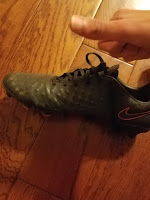When I was five-years-old, my dad had been diagnosed with diabetes. Ever since then my family's meal choices have changed, and blood sugar spikes or drops cause my dad to have to eat or take insulin. He also has to take insulin before every meal so his blood sugar doesn't spike in the first place. So I've done this research to help me and others better understand what diabetes is and how to better live with it. So lets start with the first question:
What is Diabetes?
Diabetes is difficult to define as one thing because of all the different types. But when most people use this word they talk about "Diabetes Mellitus". Which is where the body cannot produce enough insulin or the body does not accept the insulin produced. So I will just cover the main types of diabetes, type 1 and type 2. The symptoms of these types are the same really, with a few rare ones thrown into the mix, but some the main symptoms of both types of diabetes is:
- Frequently having to go to the bathroom
- Excessive thirst
- Easily tired or exhausted
- Sleepy
- Extreme hunger
- Blurred vision
- Weight loss or difficulty gaining weight
What Is Type 1 Diabetes?
Type 1, also used to be known as "Juvenile Diabetes", is a chronic condition. this condition prevents the pancreas from creating enough insulin. This also causes the beta cells to not function. Beta cells are cells that recognize when even amounts of glucose are released into specific cells. So then the beta cells produce the insulin that regulate the glucose levels. Insulin is a hormone that is responsible for how your body stores and uses glucose. There are two different versions of type 1, these versions are Autoimmune Disease and Acquired Disease.
-Autoimmune Disease: Autoimmune Disease is a disorder that causes your immune system malfunctions. The immune system starts attacking good cells, thinking they're bad cells. This can cause a lot of harm to your organs and a variety of tissues. In this case the immune systems attack the beta cells, which then the beta cells cannot produce insulin, this makes the glucose levels in the bloodstream eventually toxic.
-Acquired Disease: Acquired Disease is rare. But when "acquired", it is usually because of pancreatic cancer or an accident that injures your pancreas. This is when the beta cell count is affected. The pancreas cannot produce enough beta cells to provide enough insulin for the body.
The treatment used for Type 1 is insulin injection and/or a pancreas transplant.
What Is Type 2 Diabetes?
Type 2 Diabetes is a chronic metabolic disorder. Meaning a disease that causes high blood pressure, high blood sugar, and other things that increase rate of heart disease, stroke, and diabetes. Type 2 is when the beta cells/agent in cells may resist naturally produced insulin and glucose, causing the glucose to go back into the bloodstream until acted upon by medicine.
There is a great (and long, but worth it) analogy in a book I am reading called "The Ultimate Guide to Diabetes Type 1 & 2" by Barbara P. Trisler. The analogy of the cause of Type 2 is "Imagine a pizza delivery guy, who delivers pizza for free. Every minute, he delivers a pizza to your house. Perhaps, for the first dozen boxes, you still get excited, because pizza is great. However, after a few dozen more, you would tell the pizza guy to stop delivering.
If he continues to deliver, you will stop opening the door to him, so he would send the pizza to our neighbors. But, your neighbor has been receiving the same amount of pizza and refused to accept it. The pizza guy would have no choice but to find a place to deliver the pizza. The pizza may become rotten and toxic, before e can find a new recipient, and when they eventually receive it, it causes them harm" (Trisler 39).
That is Type 1 & 2. If you have any questions let me know in the comments. I would love your feedback!
DISCLAIMER: This article provides information regarding the subject matter covered. However, information provided does NOT replace medical or professional advice. The author specifically disclaims any liability that is incurred from the use or application of the information.
Works Cited:
Mayo Clinic. Metabolic Syndrome. Mayo Clinic, 2017. Mayoclinic.org. Web. 11/30/17.
Trisler, Barbara P. The Ultimate Guide to Diabetes Type 1 & 2. Barbara P. Trisler, 2017. Print.

















